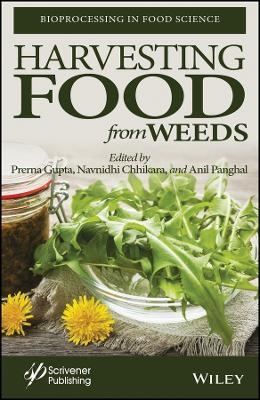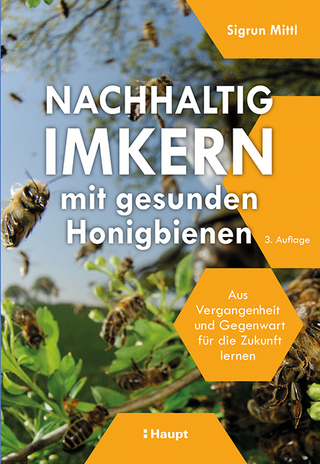
Harvesting Food from Weeds
Wiley-Scrivener (Verlag)
978-1-119-79197-3 (ISBN)
- Titel ist leider vergriffen;
keine Neuauflage - Artikel merken
With the world’s population continuing to grow exponentially, with many “food deserts” across the globe, including even in rich countries, food production is more important than ever. Finding alternative ways to produce food, in a sustainable way, is increasingly important and something that is on the minds of scientists, engineers, policy makers, and other professionals. Weeds are mainly undesirable plants, but nowadays researchers are exploring these weeds as a food source. Weeds can also grow in adverse climatic conditions with minimum nutritional requirements. Weeds that are rich in nutrients and bioactive compounds are suitable ingredients for functional foods and meet nutritional requirements at a cheaper cost and thus are lucrative and attractive for the food industry.
This latest volume in the groundbreaking series, “Bioprocessing in the Food Industry,” covers different types of weeds, like eleusine indica, tribulus terrestris, hibiscus cannabinus, corchorus, gynandra gynandropsis, and many others. These weeds have limited food applications, mainly because of traditional food production. This book will provide detailed knowledge regarding the nutritional value, health benefits and processing methods of these weeds. Readers will learn how these weeds can be utilized for food production, healthy food development, and sustainability. Combining the technological requirements, food safety and quality, this book showcases the utilization of modern technologies to process food products with great benefits. The volume will comprehensively meet the knowledge requirements for the curriculum of undergraduate, postgraduate and research students for learning the concepts of bioprocessing in food engineering, as well as veteran engineers, policy makers, scientists, chemists, and other industry professionals. It is a must have for any library.
Prerna Gupta, PhD, is an assistant professor in the Department of Food Technology and Nutrition, Lovely Professional University, India. She has published numerous research papers and review papers in scientific and technical journals and two book chapters. She is an active member of the Association of Food Scientists and Technologists and is as a reviewer in for two journals. Navnidhi Chhikara, PhD, is an assistant professor in the Department of Food Technology at Guru Jambheshwar University of Science and Technology, Hisar, India. She has eleven years of teaching and research experience and has taught various subjects, including health foods and food safety at the graduate and postgraduate levels. She has published more than sixty research papers in scientific and technical journals, is an editor and editorial board member of multiple international journals, and has received numerous awards for her scholarship. Anil Panghal, PhD, is an assistant scientist in the Department of Processing and Food Engineering at CCS Haryana Agricultural University. Previously, he worked with Nestle as a production manager for nine years. His areas of expertise include bioprocessing, manufacturing, food chemistry, food science, and technology, FSMS, and nutrition. He obtained his PhD in food technology, focusing on the molecular and physicochemical quality aspects of commercial wheat varieties. He has published various research papers in reputed journals and chapters for international publishers.
Preface xiii
1 Chenopodium Species 1
Priyanka Kundu and Prerna Gupta
1.1 Introduction 2
1.2 Chenopodium Varieties 4
1.3 Growth and Plantation 4
1.4 Health Effects 5
1.5 Medicinal Values 7
1.6 Anti-Nutritional Factors 11
1.7 Methods of Elimination of Anti-Nutritional Factors 12
1.8 Traditional Food Products 13
1.9 Future Scope 15
1.10 Conclusion 15
References 16
2 Herbs of Asteraceae Family: Nutritional Profile, Bioactive Compounds, and Potentials in Therapeutics 21 Chinaza Godswill Awuchi and Sonia Morya
2.1 Introduction 22
2.2 Future Prospects 46
2.3 Conclusion 46
References 47
Appendix A: Comprehensive List of Plants in Asteraceae Family 57
3 Tribulus terrestris: Pharmacological and Nutraceutical Potential 79
Jyoti Singh, Jaspreet Kaur, Mansehaj Kaur, Anvi Rana, Prasad Rasane and Sawinder Kaur
3.1 Introduction 79
3.2 Chemical Composition and Active Constituents Possessed by Tribulus terrestris 83
3.3 Nutritional and Antinutritional Content of Leaves of Tribulus terrestris 84
3.4 Medicinal Benefits of TT Extracts 86
3.5 Ayurvedic Importance and Recommendations 87
3.6 Biological Activities of Tribulus terrestris 87
3.7 Pharmacological Profiling of Tribulus terrestris 96
3.8 Mechanisms of Action of Tribulus terrestris 100
3.9 Effects of Herbal Supplements with Medication Effects 101
3.10 Herb-Drug Interconnection 103
3.11 Toxicity and Dosage 104
3.12 Conclusion 105
References 106
4 Eleusine Indica 113
Piyush Kashyap, Deep Shikha, Sunakshi Gautam and Umexi Rani
4.1 Origin and History 114
4.2 Botanical Explanation 114
4.3 Production, Development, and Maturation 115
4.4 Nutritional Profile 116
4.5 Bioactives: Pharmacology and Bioactive 117
4.6 Pharmacology 119
4.7 Health Benefits 132
4.8 Future Prospectus and Conclusion 136
References 136
5 Hemp (Cannabis sativa L.) Agronomic Practices, Engineering Properties, Bioactive Compounds and Utilization in Food Processing Industry 143
Vipul Mittal, Anil Panghal and Ravi Gupta
5.1 Introduction 144
5.2 Hemp Taxonomic Classification 146
5.3 Agronomic Practices/Growing Condition for Hemp Cultivation 147
5.4 Hemp Phytomorphology 149
5.5 Hemp Plant Parts 150
5.6 Bioactive Compounds 152
5.7 Pharmacological Properties 162
5.8 Processing Technologies (Methods and Effects) 167
5.9 Conclusion and Prospects for the Future 172
References 173
6 Ocimum Species 183
Deep Shikha and Piyush Kashyap
6.1 Origin and History 184
6.2 Botanical Distribution 185
6.3 Production 186
6.4 Development and Maturation 187
6.5 Nutritional Profile 188
6.6 Bioactive Compounds 189
6.7 Pharmacological Aspect 201
6.8 Health Benefits 205
6.9 Industrial Utilization 206
6.10 Conclusion and Future Prospectus 207
References 207
7 Role of Bioactive Compounds of Bauhinia variegata and their Benefits 217
Deepika Kaushik, Mukul Kumar, Ravinder Kaushik and Ashwani Kumar
7.1 Introduction 218
7.2 Origin and Distribution of Bauhinia variegata 219
7.3 Cultivation 219
7.4 Morphology 219
7.5 Composition 221
7.6 Bioactive Compound of Bauhinia variegta 222
7.7 Role and Structure of Bioactive Compounds of Bauhinia variegta 223
7.8 Traditional Uses as a Food 225
7.9 Therapeutic Value of Bauhinia variegata 238
7.10 Health Benefits of Bauhinia variegatata 255
7.11 Other Uses 257
8 Hibiscus cannabinus 267
Deep Shikha, Piyush Kashyap, Abhimanyu Thakur and Madhusudan Sharma
8.1 Origin and History 268
8.2 Botanical Description 269
8.3 Production 271
8.4 Development and Maturation 272
8.5 Nutritional Profile 273
8.6 Bioactive Compounds 278
8.7 Pharmacology 300
8.8 Health Benefits 309
8.9 Industrial Use 310
8.10 Conclusion and Future Prospectus 316
References 317
9 Dhatura: Nutritional, Phytochemical, and Pharmacological Properties 327
K.M. Manju, Ritu Sindhu, Priyanka Rohilla and Rohit Kumar
9.1 Introduction 327
9.2 Botanical Description 328
9.3 Nutritional Properties and Phytochemistry 330
9.4 Properties of Plant 332
9.5 Applications 341
9.6 Toxic Effects of Datura Plant 341
9.7 Conclusion 342
References 343
10 Bioactive Properties and Health Benefits of Amaranthus 351
Nisha Singhania, Rajesh Kumar, Pramila, Sunil Bishnoi, Aradhita B. Rayand Aastha Diwan
10.1 Introduction 352
10.2 Species 353
10.3 Plant Physiology and Environmental Factors for Growth of Amaranth 354
10.4 Edible Part and Uses 356
10.5 Nutritional Properties 356
10.6 Non-Nutritional Compounds 368
10.7 Medicinal Properties 369
10.8 Conclusion 376
References 377
11 Corchorus Species: Health Benefits and Industrial Importance 385
Kavya Ganthal, Nehal Sharma and Narinder Kaur
11.1 Introduction 385
11.2 Various Species of Corchorus 388
11.3 Future Scope 403
References 403
Index 407
| Erscheinungsdatum | 17.08.2022 |
|---|---|
| Sprache | englisch |
| Gewicht | 848 g |
| Themenwelt | Technik |
| Weitere Fachgebiete ► Land- / Forstwirtschaft / Fischerei | |
| ISBN-10 | 1-119-79197-9 / 1119791979 |
| ISBN-13 | 978-1-119-79197-3 / 9781119791973 |
| Zustand | Neuware |
| Haben Sie eine Frage zum Produkt? |
aus dem Bereich


